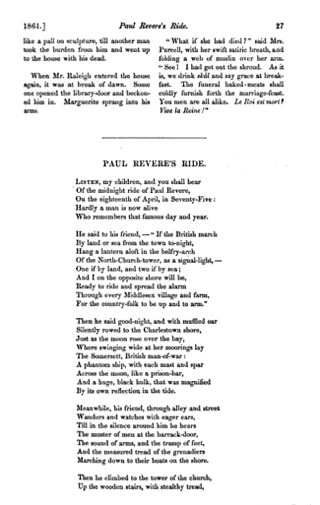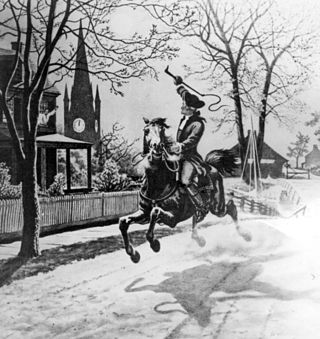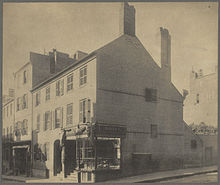
Paul Revere was an American silversmith, engraver, folk hero, early industrialist, Sons of Liberty member, and Patriot. He is best known for his midnight ride to alert the colonial militia in April 1775 to the approach of British forces before the battles of Lexington and Concord, as dramatized in Henry Wadsworth Longfellow's 1861 poem, "Paul Revere's Ride".

William Dawes Jr. was an American soldier, and was one of several men who, in April 1775, alerted minutemen in Massachusetts of the approach of British regulars prior to the battles of Lexington and Concord at the outset of the American Revolution. For some years, Paul Revere had the most renown for his ride of warning of this event.

Copp's Hill is an elevation in the historic North End of Boston, Massachusetts. It is bordered by Hull Street, Charter Street and Snow Hill Street. The hill takes its name from William Copp, a shoemaker who lived nearby. Copp's Hill Burying Ground is a stop on the Freedom Trail.

Joseph Warren, a Founding Father of the United States, was an American physician who was one of the most important figures in the Patriot movement in Boston during the early days of the American Revolution, eventually serving as President of the revolutionary Massachusetts Provincial Congress. Warren enlisted Paul Revere and William Dawes on April 18, 1775, to leave Boston and spread the alarm that the British garrison in Boston was setting out to raid the town of Concord and arrest rebel leaders John Hancock and Samuel Adams. Warren participated in the Battles of Lexington and Concord the following day, the opening engagements of the American Revolutionary War.

The Old North Church, is an Episcopal mission church located in the North End neighborhood of Boston. The church, which was built in 1723, is the oldest standing church building in Boston and a National Historic Landmark.

Samuel Prescott was an American physician and a Massachusetts Patriot during the American Revolutionary War. He is best known for his role in Paul Revere's "midnight ride" to warn the townspeople of Concord, Massachusetts, of the impending British army move to capture guns and gunpowder kept there at the beginning of the American Revolution. He was the only participant in the ride to reach Concord.

The Granary Burying Ground in Massachusetts is the city of Boston's third-oldest cemetery, founded in 1660 and located on Tremont Street. It is burial location of Revolutionary War-era patriots, including Paul Revere, the five victims of the Boston Massacre, and three signers of the Declaration of Independence: Samuel Adams, John Hancock, and Robert Treat Paine. The cemetery has 2,345 grave-markers, but historians estimate that as many as 5,000 people are buried in it. The cemetery is adjacent to Park Street Church, behind the Boston Athenaeum and immediately across from Suffolk University Law School. It is a site on Boston's Freedom Trail. The cemetery's Egyptian revival gate and fence were designed by architect Isaiah Rogers (1800–1869), who designed an identical gate for Newport's Touro Cemetery.

The Boston National Historical Park is an association of sites that showcase Boston's role in the American Revolution and other parts of history. It was designated a national park on October 1, 1974. Seven of the eight sites are connected by the Freedom Trail, a walking tour of downtown Boston. All eight properties are National Historic Landmarks.

The Battles of Lexington and Concord were some of the leading military engagements of the American Revolutionary War. The battles were fought on April 19, 1775, in Middlesex County, Province of Massachusetts Bay, within the towns of Lexington, Concord, Lincoln, Menotomy, and Cambridge. They marked the outbreak of armed conflict between the Kingdom of Great Britain and Patriot militias from America's thirteen colonies.
Israel Bissell was a patriot post rider in Massachusetts who brought news to American colonists of the British attack on Lexington and Concord on April 19, 1775. He reportedly rode for four days and six hours, covering the 345 miles from Watertown, Massachusetts to Philadelphia along the Old Post Road, shouting "To arms, to arms, the war has begun", and carrying a message from General Joseph Palmer, which was copied at each of his stops and redistributed. It is said that Isreal Bissell was the inspiration for song "Paul Revere's Ride", by Henry Wadsworth Longfellow.
Robert Newman may refer to:

Samuel Stillman (1737–1807) was an American Baptist minister. From 1765 until his death in 1807, Stillman served as pastor of Boston's First Baptist Church of Boston, Massachusetts; for these 42 years, Stillman was considered "the leading Baptist minister in New England, if not the United States." Stillman was an original trustee of Rhode Island College and played a leading role in the establishment of the Massachusetts Baptist Missionary Society in 1802.

Copp's Hill Burying Ground is a historic cemetery in the North End of Boston, Massachusetts. Established in 1659, it was originally named "North Burying Ground", and was the city's second cemetery.

"Paul Revere's Ride" is an 1860 poem by American poet Henry Wadsworth Longfellow that commemorates the actions of American patriot Paul Revere on April 18, 1775, although with significant inaccuracies. It was first published in the January 1861 issue of The Atlantic Monthly. It was later retitled "The Landlord's Tale" in Longfellow's 1863 collection Tales of a Wayside Inn.
Thaddeus Bowman was the last scout sent out by Capt. John Parker at Lexington, Massachusetts, but the only one to find the approaching British troops and get back to warn the militia on the first day of the American Revolution.

The Lexington–Concord Sesquicentennial half dollar, sometimes the Lexington–Concord half dollar or Patriot half dollar, is a commemorative fifty-cent piece struck by the United States Bureau of the Mint in 1925 in honor of the 150th anniversary of the Battles of Lexington and Concord, which began the American Revolutionary War. It was designed by Chester Beach and features Daniel Chester French's 1874 The Minute Man statue on the obverse.
John Pulling Jr was an American captain, vestryman and Patriot who, along with Robert Newman, signaled Paul Revere from the Old North Church in Boston before Revere's midnight ride.
John Pigeon was a merchant, a member of the Massachusetts Provincial Congress, and Massachusetts Commissary General during the American Revolution.

The Midnight Ride was the alert to the American colonial militia in April 1775 to the approach of British forces before the battles of Lexington and Concord.

The Old Belfry is a historic structure on Clarke Street in Lexington, Massachusetts, United States. It stands on Belfry Hill.















